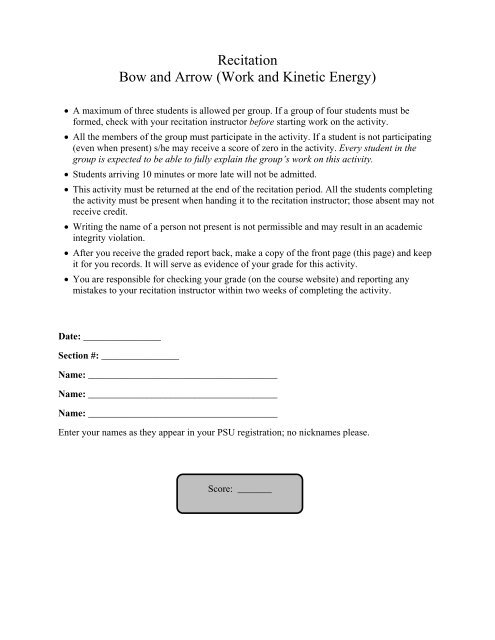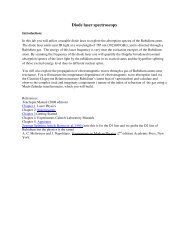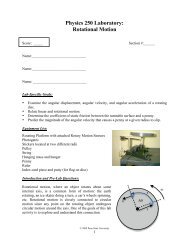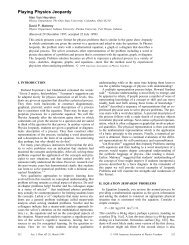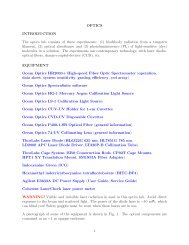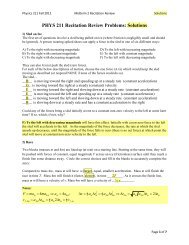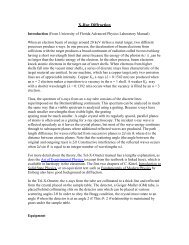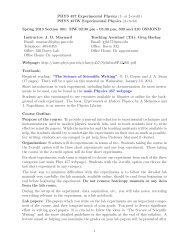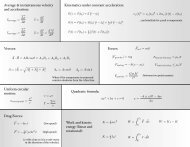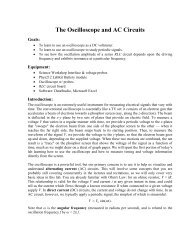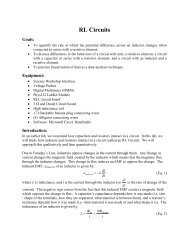Recitation Bow and Arrow (Work and Kinetic Energy)
Recitation Bow and Arrow (Work and Kinetic Energy)
Recitation Bow and Arrow (Work and Kinetic Energy)
You also want an ePaper? Increase the reach of your titles
YUMPU automatically turns print PDFs into web optimized ePapers that Google loves.
<strong>Recitation</strong><br />
<strong>Bow</strong> <strong>and</strong> <strong>Arrow</strong> (<strong>Work</strong> <strong>and</strong> <strong>Kinetic</strong> <strong>Energy</strong>)<br />
A maximum of three students is allowed per group. If a group of four students must be<br />
formed, check with your recitation instructor before starting work on the activity.<br />
All the members of the group must participate in the activity. If a student is not participating<br />
(even when present) s/he may receive a score of zero in the activity. Every student in the<br />
group is expected to be able to fully explain the group’s work on this activity.<br />
Students arriving 10 minutes or more late will not be admitted.<br />
This activity must be returned at the end of the recitation period. All the students completing<br />
the activity must be present when h<strong>and</strong>ing it to the recitation instructor; those absent may not<br />
receive credit.<br />
Writing the name of a person not present is not permissible <strong>and</strong> may result in an academic<br />
integrity violation.<br />
After you receive the graded report back, make a copy of the front page (this page) <strong>and</strong> keep<br />
it for you records. It will serve as evidence of your grade for this activity.<br />
You are responsible for checking your grade (on the course website) <strong>and</strong> reporting any<br />
mistakes to your recitation instructor within two weeks of completing the activity.<br />
Date: ________________<br />
Section #: ________________<br />
Name: _______________________________________<br />
Name: _______________________________________<br />
Name: _______________________________________<br />
Enter your names as they appear in your PSU registration; no nicknames please.<br />
Score: _______
<strong>Bow</strong> <strong>and</strong> <strong>Arrow</strong> (<strong>Work</strong> <strong>and</strong> <strong>Kinetic</strong> <strong>Energy</strong>)<br />
The bow <strong>and</strong> arrow is one of the oldest weapons of warfare <strong>and</strong> new<br />
developments in bow technology could tip the balance in battle. Henry V’s<br />
victory against the French at the famous battle of Agincourt (1415), in which<br />
the English were outnumbered four to one, was due in part to their effective<br />
use of the Welsh (or English) longbow, which allowed the English archers to<br />
shoot more rapidly than crossbow archers <strong>and</strong> release arrows with sufficient<br />
energy to pierce the armor of the French knights 1 . A modern (1966)<br />
development in bow technology is that of the compound bow, shown to the<br />
right, in which cams (eccentric pulleys) are used to increase the energy stored<br />
in the bow but decrease the force required to keep the string fully drawn.<br />
A bow is just a spring with an unusual shape. As the arrow is drawn back on<br />
the bowstring, the body of the bow flexes <strong>and</strong> stores elastic potential energy.<br />
However, unlike an ideal spring, the force exerted by the bowstring is not<br />
necessarily proportional to the distance that the bowstring is displaced. The<br />
modern compound bow has eccentric pulleys on either end that cause it to act<br />
like a very non-ideal spring. By design, the force required to pull a modern<br />
bow does not increase linearly with distance. You have just bought a<br />
compound bow at a garage sale <strong>and</strong> you want to figure out its parameters,<br />
such as how much energy you can store in it, how fast it will shoot an arrow,<br />
how hard it is to hold fully drawn, <strong>and</strong> how far the arrow will travel. After<br />
taking some measurements, you <strong>and</strong> a friend head off to the archery range.<br />
Objective: By the end of this activity, you should be able to calculate <strong>Work</strong><br />
from knowing the force exerted as a function of position <strong>and</strong> be able to relate<br />
<strong>Work</strong> to the change in kinetic energy K.<br />
1. You decide that the easiest way to measure the force required to displace<br />
the bowstring is to hang the bow from the ceiling <strong>and</strong> then pull down on<br />
the bowstring while st<strong>and</strong>ing on a scale. Draw a free-body force diagram<br />
for yourself st<strong>and</strong>ing on the scale grasping the string of the hanging bow.<br />
Then write an equation employing Newton’s Second Law <strong>and</strong> then show<br />
how you can use that equation to determine the upward force exerted by<br />
the bowstring (F bow ) from your scale measurements (F N ).<br />
1 See chapter 3 (“Distance Voices”) of Connections (1978) by James Burke for more details <strong>and</strong><br />
to see how improvements in agricultural technology ultimately led to the demise of the longbow<br />
as a weapon. For a literary take on this famous battle, delve into Shakespeare’s Henry V.
2. Using your bathroom scale, you have measured your normal force F N as a function of the<br />
displacement of the bowstring. (Your mass in 80 kg.) From your data, determine the force<br />
exerted on the bowstring F bow <strong>and</strong> make a plot of F bow vs. Stretch Distance. Be sure to<br />
indicate the scale on the Force axis.<br />
Stretch Distance (m) Scale Force F N (N) <strong>Bow</strong> Force F bow (N)<br />
0.00 784<br />
0.05 748<br />
0.10 711<br />
0.15 675<br />
0.20 636<br />
0.25 618<br />
0.30 613<br />
0.35 636<br />
0.40 670<br />
0.45 686<br />
0.50 691<br />
3. Show on your graph above how you could use the graph to calculate the <strong>Work</strong> you did on the<br />
bow by pulling back the string as far as you did (but do not do the calculation itself yet).<br />
Explain below in words.
4. Looking at your force graph, you notice something about the restoring force exerted by your<br />
bow that is quite different from a linear spring for large extensions. What is this difference<br />
from a linear spring <strong>and</strong> why might the bow be designed for this to happen? (Hint: Imagine<br />
yourself holding the bow <strong>and</strong> trying to aim the arrow as you keep the string stretched.)<br />
5. A friend helping you out looks at your Force versus distance graph <strong>and</strong> says, “Hey, the force<br />
decreases after about 0.3 meters, so pulling it back any further just reduces the <strong>Work</strong> you’ve<br />
done.” You look at the graph <strong>and</strong> say to your friend:<br />
6. Write an analytic expression for the <strong>Work</strong> done during the interval described by your first<br />
three data points <strong>and</strong> simplify as much as possible. Call the Force values F 1 , F 2 , <strong>and</strong> F 3 , <strong>and</strong><br />
the uniform spacing between distance measurements d. (Hint: consider the trapezoid shown<br />
below, on the right.)<br />
F<br />
F 2 F 3<br />
F 1<br />
h 1<br />
h 2<br />
x<br />
w<br />
A = ½(h 1 +h 2 )w<br />
Now, if you simplified your expression for the <strong>Work</strong> for three data points, you should see a<br />
pattern in terms of end points <strong>and</strong> middle points. How would you modify your expression to<br />
add a fourth data point (F 4 ), also a spacing d apart?
7. Assuming that all of the work done on the bowstring is stored in the bent bow, determine the<br />
amount of energy stored in the bow at full extension (0.5 m). Call this energy, E bow-f .<br />
(Generalize what you did in question 6 above for more than 3 & 4 data points.)<br />
CHECK WITH AN INSTRUCTOR AT THIS POINT<br />
8. You want to estimate the release speed of an arrow (which you have measured to have a<br />
mass of M = 0.02 kg) launched horizontally. You estimate that about 80% of the energy in<br />
the bow goes to kinetic energy K of the arrow. What is the speed of the arrow as it leaves the<br />
bow? First put your answer in terms of E bow-f <strong>and</strong> M, then solve for the numerical value.<br />
Where did the other 20% of E bow-f go?
9. If you aim the arrow directly horizontal <strong>and</strong> shoot at a target a distance X = 30 meters away,<br />
how far above or below the bulls-eye (1 meter below the arrow’s release height) will the<br />
arrow hit the target? (Neglect the Drag force from the air on the arrow.) [Solve first using<br />
variables <strong>and</strong> then calculate the numerical value.]<br />
10. When you reach the target, you measure that the arrow penetrated the target by a distance of<br />
D = 0.05 m. From this, you are able to determine that the average 2 force exerted by the arrow<br />
on the target as it pierced the target was: (First, work it out using variables <strong>and</strong> then calculate<br />
the numerical value.)<br />
CHECK WITH AN INSTRUCTOR AT THIS POINT<br />
Finally, you notice that while you aimed the arrow horizontally, it wasn’t pointing horizontally<br />
when it hit the target; rather, the arrow seemed to point along its trajectory. You wonder why that<br />
is – that is, what mechanism turned the arrow so that the arrowhead always pointed in the<br />
direction it was moving – <strong>and</strong> you wonder whether that would also happen if you shot the arrow<br />
in a vacuum. “I’ll have to research that,” you say to your friend as you pull out the arrow.<br />
2 This is the average by distance, not a time average; the average force by distance <strong>and</strong> the<br />
average force by time are only exactly equal when the average speed is half the impact speed.


